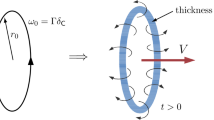Abstract
An elliptic relaxation model is proposed for the strongly inhomogeneous region near the wall in wall-bounded turbulent shear flow. This model enables the correct kinematic boundary condition to be imposed on the normal component of turbulent intensity. Hence, wall blocking is represented. Means for enforcing the correct boundary conditions on the other components of intensity and on the k — ɛ equations are discussed. The present model agrees quite well with direct numerical simulation (DNS) data. The virtue of the present approach is that arbitrary “damping functions” are not required.
Similar content being viewed by others
References
Gartshore, I.S., Durbin, P.A., and Hunt, J.C.R. (1983) The production of turbulent stress in a shear flow by irrotational fluctuations. J. Fluid Mech. 193, 475–497.
Gibson M.M., and Launder, B.E. (1978) Ground effects on pressure fluctuations in the atmospheric boundary layer. J. Fluid Mech. 86, 491–511.
Hanjalic, K., and Launder, B.E. (1976) Contribution towards a Reynolds-stress closure for low-Reynolds-number turbulence. J. Fluid Mech. 74, 593–610.
Hunt, J.C.R., and Graham, J.M.R. (1978) Free-stream turbulence near plane boundaries. J. Fluid Mech. 84, 209–235.
Kim, J., Moin, P., and Moser, R. (1978) Turbulence statistics in fully developed channel flow at low Reynolds number. J. Fluid Mech. 177, 133–166.
Launder, B.E. (1986) Low Reynolds Number Turbulence Near Walls. Report TFD/86/4, Dept. of Mech. Eng., UMIST, Manchester.
Launder, B.E., Reece, G.J., and Rodi, W. (1975) Progress in the development of a Reynolds-stress turbulence closure. J. Fluid Mech. 68, 537–566.
Lumley, J.L. (1978) Computational modelling of turbulent flows. Adv. Appl. Mech. 18, 126–176.
Mansour, N.N., Kim, J., and Moin, P. (1988) Reynolds-stress and dissipation-rate bundgets in a turbulent channel flow. J. Fluid Mech. 194, 15–44.
Mansour, N.N., Kim, J., and Moin, P. (1989) Near-wall k — ɛ turbulence modeling. AIAA J. 27, 1068–1073.
Patel, V.C., Rodi, W., and Scheurer, W. (1985) Turbulence models for near-wall and low Reynolds number flows: a review. AIAA J. 23, 1308–1319.
Rodi, W. (1976) A new algebraic relation for calculating the Reynolds stresses. Z. Argew. Math. Mech. 56, T219–221.
Rotta, J.C. (1951) Statistiche theorie nichthomogener turbulenz. Z. Phys. 129, 547–572.
Shih, T.H. (1990) An improved k — ɛ model for near wall turbulence and comparison with direct numerical simulations. In preparation
Thomas, N.H., and Hancock, P.E. (1977) Grid turbulence near a moving wall. J. Fluid Mech. 82, 481–496.
Townsend, A.A. (1976) The Structure of Turbulent Shear Flow, Cambridge University Press, Cambridge.
van Driest, E.R. (1956) On turbulent flow near a wall. J. Aero. Sci. 23, 1007–1011.
Author information
Authors and Affiliations
Additional information
Communicated by John Lumley
Rights and permissions
About this article
Cite this article
Durbin, P.A. Near-wall turbulence closure modeling without “damping functions”. Theoret. Comput. Fluid Dynamics 3, 1–13 (1991). https://doi.org/10.1007/BF00271513
Received:
Accepted:
Issue Date:
DOI: https://doi.org/10.1007/BF00271513




